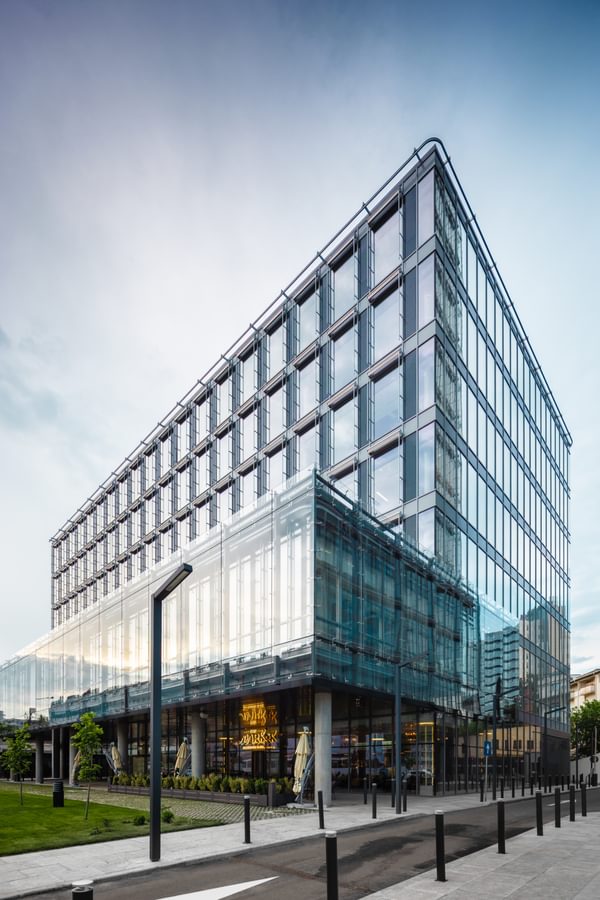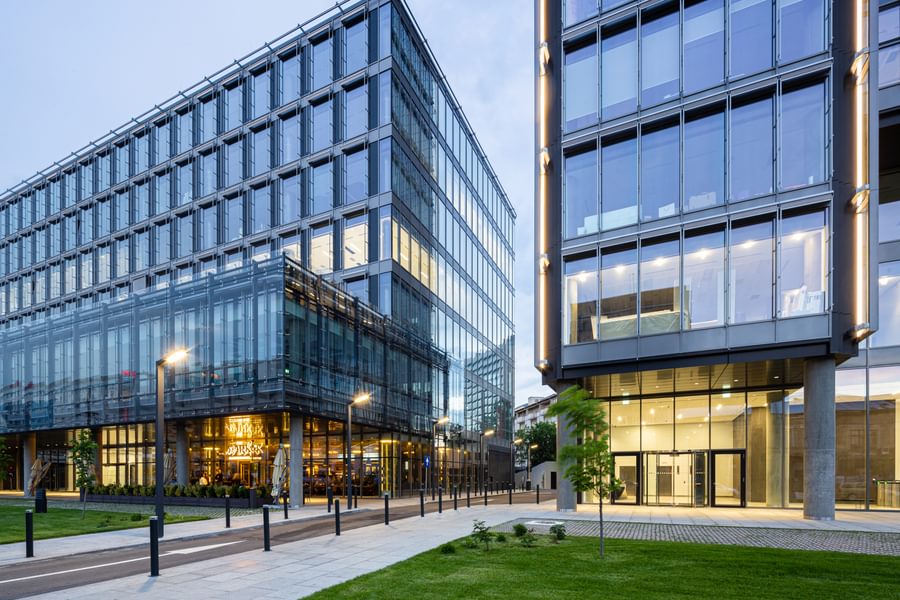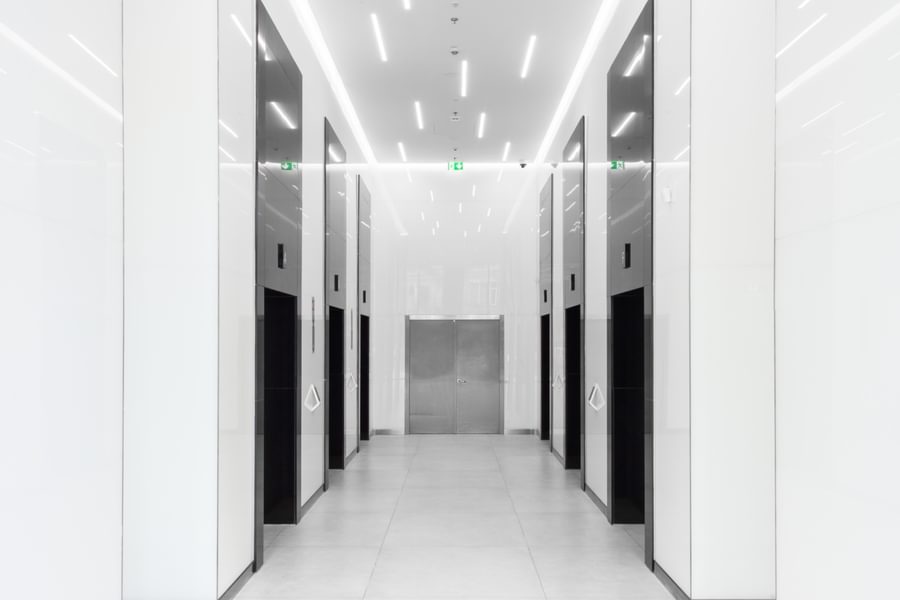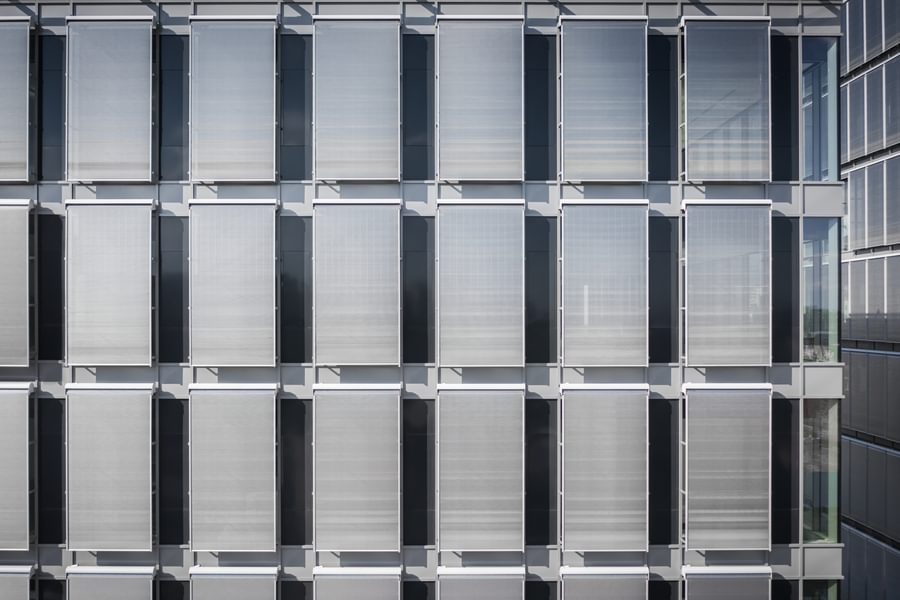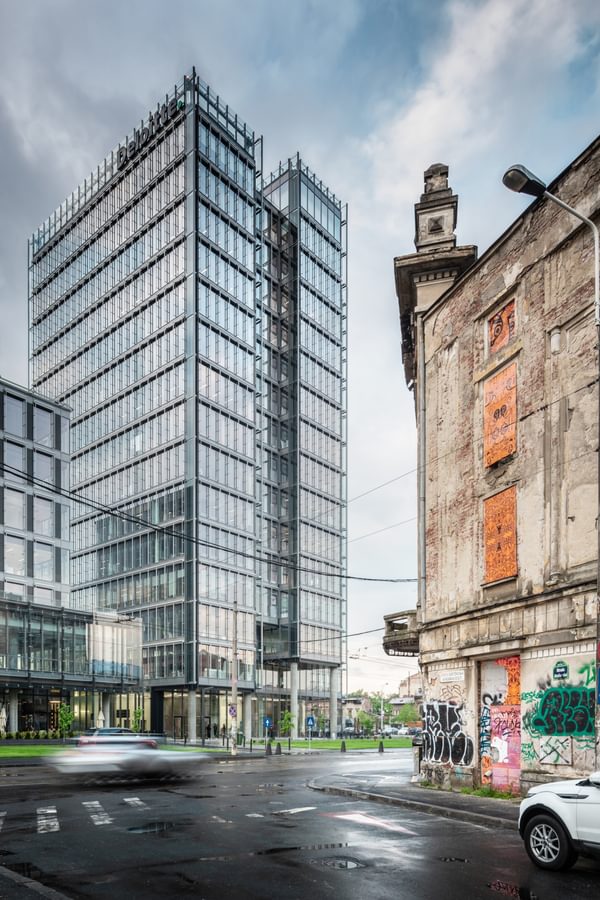
Project Profile: The Mark – highly sustainable workspace for blue-chip companies in Bucharest
The Mark is a Class A office scheme near Bucharest city centre, close to the Gara de Nord railway station. Comprising two buildings, the complex contains a 15-storey tower and a six-floor podium, with a total of 28,000m2 above ground and 12,500m2 of underground space including 297 car parking spaces. The offices are rated BREEAM Excellent for sustainability, and offer high-quality user space served by high-speed lifts and excellent access to Bucharest’s public transport links.
Chapman Taylor was the Lead Designer on this project, involved from concept development through to tender. It also acted as Design Consultant on behalf of the client, S IMMO AG, in relation to site monitoring and design specification clarification. In this profile piece, Associate Director Igor Bergmann talks about the process of designing this highly sustainable and state-of-the-art workplace for blue-chip companies.
Tell us about the origins of the scheme and its design development.
We had previously worked with the client, S IMMO, on the successful Sun Plaza shopping and leisure project, which opened in Bucharest in 2010. S IMMO bought a site to the west of Bucharest city centre, near Gara de Nord railway station, and obtained a planning permit. It then asked Chapman Taylor to take the role of Lead Architect on the project - the buildings’ volumes and positions were therefore already delineated when we began to consider the design.
The brief was to create three concept options for the development, all with a strong emphasis on low energy consumption, and we worked very closely with engineers from Arup, who led on structures, MEP and façades, to evaluate various options for the concepts we created. Each option had different consequences for the MEP riser dimensions, façade parameters, return on investment, running costs, etc. Based on these factors, the client chose the design option which was focused on achieving the best sustainability credentials.
Our massing concept for the tower building was designed as an interpretation of an untidy bookcase with varying book heights. The façade uses materials to express the building’s functions honestly through the use of glass, aluminium, exposed concrete and stainless steel.
The extended planes of the façade soften the building’s corners, with a similar approach used at roof level – giving the impression of the building blending seamlessly with the sky. At night, the façade features are gently lit in a way which accentuates the building “crown”. The external shading system is able to double as a cinematic canvas onto which images can be projected for events. Each sun protection louvre is connected individually to the building management system and can be programmed to generate interesting kinetic art performances.
The lighting concept uses different temperatures of white light for both the interior and exterior, which supports the monochrome palette of black and white used in the interior spaces and serves as a reference to the old films shown at the well-loved cinema that once occupied a nearby site.
We adopted a minimalist approach for the interior design, using a combination of natural stone and white glass wall cladding, with flat white ceilings and large format ceramic floor tiles. The wayfinding signage for the entire building was created by the artist Aldo Giannotti, with original hand-drawn sketches on each floor. The buildings are not just functional and efficient, but bring elements of original creativity and fun, making them enjoyable places in which to work and spend time.
What challenges did the site present?
The site is narrow, yet the buildings’ volumes are large, demanding three basement levels to accommodate the necessary parking - which was not easy, given the site’s central location within the city. The construction required a lot of temporary bracing work during the excavation of the basements.
We wanted to maximise the amount of natural light received throughout the building, but had to reconcile this with minimising solar heat gains to avoid high cooling loads during the summer months. The tower is also quite tall, and Bucharest can experience very strong winds, making the use of standard external blinds problematic. Our solution was to use extensive floor-to-ceiling glazing to maximise the benefits of natural light, while, to manage the solar gains, we employed an innovative type of external shading rarely used in Europe; stainless steel mesh roller blinds were installed, giving great solar protection while allowing almost uninhibited views from the building when the louvres are down.
Bucharest lies in a seismically active region, so the building is also designed to withstand the enormous forces earthquakes create. We didn’t want to have any sheer walls in the façade plane, or to use cross-bracing, so the seismic load is borne by a combination of the buildings’ columns and the heavy central core.
How did you design for optimum environmental sustainability and wellbeing?
Our design focused on the needs of end-users, including their physical and mental wellbeing – encouraging collaboration, movement and relaxation while allowing in abundant natural light.
The buildings make use of energy-efficient lighting and a fully integrated lighting control system to minimise energy consumption, as well as infra-red sensor-fitted appliances in the WC facilities. In addition, we used solar technology for sustainable energy creation, with the podium roof substantially covered by solar panels.
There are excellent facilities for cyclists, including bicycle storage and changing rooms. There is also easy access to Bucharest’s public transport links, encouraging people to leave their cars at home.
The development includes biodiverse garden spaces; the site is quite compact, but we tried to ensure that we added soft landscaping wherever possible. The buildings host a number of terraces and balconies at each level so that people can step outside without having to travel to the ground floor.
What did your site monitoring role involve?
The site contractor created execution drawings for the construction phases, and our role was to review every single drawing produced in fine detail, including the MEP and structural drawings (in collaboration with the specialists in those elements). We also reviewed mock-ups of the interiors, façade and other features.
The main purpose of our monitoring position was to act as design guardian, ensuring that there was no fundamental divergence from the agreed design. We were mostly focused on the final overall appearance of the building, but we paid strong attention to the detail of all components, right down to stepping in with recommendations for aesthetically suitable grilles, for example. We had on-site meetings every two weeks to monitor progress as construction advanced.
Who are the tenants at The Mark?
Deloitte has taken six floors of the tower, with the rest of the tower let to law firms and IT companies, while the podium has been leased by the world’s largest advertising company, WPP.
The tower’s ground floor hosts a large entrance foyer and some retail and F&B space for use by The Mark’s occupants and local people, providing an active frontage for the development. The first floor is now operated by a co-working company. The first floor of the podium building has a larger ceiling height to allow flexibility of use, while a double-skin façade protects the internal space from solar heat gains and noise from trams in the adjacent street.
We designed with flexibility in mind so that the buildings can be easily adapted to changing requirements. For example, the tower building, which has relatively small floorplates, was designed around a central core which hosts the bathroom spaces, while in the podium, with its larger floorplates, bathrooms are directly accessible from the tenant spaces and tenants can tailor the type of finishing to reflect their budget and interior design preferences. The way the core accommodates the bathroom spaces was designed to easily adapt to changes in tenancy formats, so that the number of toilets can expand or shrink to suit the number of tenants on a given floor.
How has the client reacted to the completed development?
S IMMO is very happy with the finished scheme, particularly because the running costs are even lower than they aimed for. The cooling and energy systems we created are actually more efficient than anticipated, which has further enhanced the reputation of The Mark as an environmentally sustainable scheme.
The client is also delighted with the design, which creates an elegant, minimalist and aesthetically pleasing landmark for this district of Bucharest. They gave us a lot of freedom in our design and provided valuable ideas during the design process. The finished complex helps to upgrade the area’s appearance and consolidate its position as the city’s prime commercial district. On the basis of this successful development, S IMMO is now exploring two further developments with us, in Romania and in Hungary.
For me, The Mark has been a career highlight. I was able to design this project without having to make major compromises, and the building is my tribute to the British high-tech and minimalist architectural pioneers who greatly influenced me during my studies. The project took more than six years to complete because of interruptions caused by the economic downturn, so it is immensely gratifying to see the building finished and occupied.
Key facts:
Sectors: Office
Services: Architecture, Interiors
Client: S IMMO AG
Area: 42,500m² GBA
Status: Completed in 2019
Photos: Vlad Patru, @vlad.patru, vlad@node.studio


